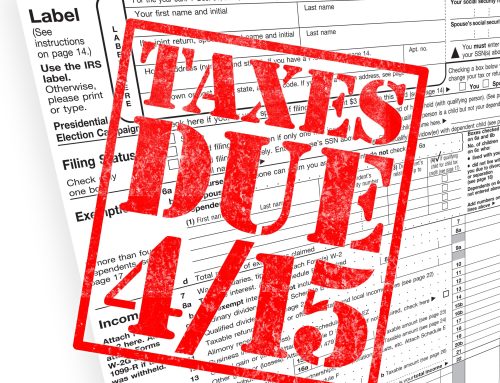Congress has once again extended the “extenders,” a varied assortment of more than 50 individual and business tax deductions, tax credits, and other tax-saving laws which have been on the books for years but which technically are temporary because they have a specific end date. This package of tax breaks has repeatedly been temporarily extended for short periods of time (e.g., one or two years), which is why they are referred to as “extenders.” Most of the tax breaks expired at the end of 2014. Now, in the recently enacted Protecting Americans from Tax Hikes Act of 2015 (i.e., the PATH Act), the extenders have been revived and extended once again, but this time Congress has taken a new tack. Instead of just rolling the package of provisions over for a year or two, it actually made some of the provisions permanent and extended the remaining provisions for either two or five years, while making significant modifications to several of the provisions.
I’m writing to give you an overview of the key tax breaks affecting business that were extended by the new law. Please call our office for details of how the new changes may affect you or your business. The extended business credits and special depreciation and expensing rules include:
. . . the research credit-made permanent; additionally, beginning in 2016 eligible small businesses
($50 million or less in gross receipts) may claim the credit against alternative minimum tax (AMT) liability, and the credit can be used by certain even smaller businesses against the employer’s portion of the Social Security portion of the employer’s payroll tax (i.e., FICA) liability;
. . . the minimum low-income housing tax credit rate for non-federally subsidized new buildings-made permanent;
. . . the military housing allowance exclusion for determining whether a tenant in certain counties is low-income (differential wage payment credit)-made permanent;
. . . the Indian employment tax credit-extended through 2016;
. . . the new markets tax credit-extended through 2019;
. . . the railroad track maintenance credit-extended through 2016; the new law modifies the credit to apply to expenditures for maintaining railroad track owned or leased as of Jan. 1, 2015 (rather than Jan. 1, 2005, as under prior law);
. . . the mine rescue team training credit-extended through 2016;
. . . the employer wage credit for activated military reservists-made permanent; beginning in 2016, the provision modifies the credit to apply to employers of any size, rather than employers with 50 or fewer employees, as under prior law;
. . . the work opportunity tax credit-extended through 2019; the new law also modifies the credit beginning in 2016 to apply to employers who hire qualified long-term unemployed individuals (i.e., those who have been unemployed for 27 weeks or more) and increases the credit with respect to such long-term unemployed individuals to 50% of the first $6,000 of wages
. . . qualified zone academy bonds-extended through 2016;
. . . three-year depreciation for racehorses-extended through 2016;
. . . 15-year straight line cost recovery for qualified leasehold improvements, qualified restaurant buildings and improvements, and qualified retail improvements-made permanent;
. . . 7-year recovery period for motorsports entertainment complexes-extended through 2016;
. . . accelerated depreciation for business property on an Indian reservation-extended through 2016; the new law also modifies the deduction to permit taxpayers to elect out of the accelerated depreciation rules;
. . . 50% bonus depreciation-extended to include property placed in service during 2015 through 2019 (but 2016 through 2020 for certain property with a longer production period and certain aircraft); the 50% rate is phased down to 40% for property placed in serviced during 2018 (but 2019 for the long production period property and aircraft) and 30% for property placed in serviced during
2019 (but 2020 for the long production period property and aircraft); phase down is also required for the $8,000 increase, for bonus-depreciation eligible cars, of the first-year depreciation and expensing dollar cap for cars; the provision makes qualified building improvements (no longer just qualified building leasehold improvements) bonus depreciation eligible and permits most plants bearing fruit or nuts to be eligible for bonus depreciation when planted or grafted rather than when income-producing;
. . . the election to accelerate alternative minimum tax (AMT) credits in lieu of additional first-year depreciation-extended for property placed in service during 2015; the provision modifies the AMT rules beginning in 2016 by increasing the amount of unused AMT credits that may be claimed in lieu of bonus depreciation;
. . . the enhanced charitable deduction for contributions of food inventory-made permanent; the new law modifies the deduction by increasing the limitation on deductible contributions of food inventory from 10% to 15% of the taxpayer’s adjusted gross income (15% of taxable income in the case of a C corporation) per year and also modifies the deduction to provide special rules for valuing food inventory;
. . . increase in elective business expensing (up to $500,000 annual write-off of eligible business property costs that is phased out once those costs exceed $2,000,000 for the year)-made permanent; made permanent too is the allowance of expensing for computer software and qualified real property (certain leasehold improvement, retail improvement and restaurant property); the $500,000 and $2,000,000 limits are indexed for inflation for tax years beginning after 2015; expensing is allowed for air conditioning and heating units placed in service in tax years beginning after 2015; the $250,000 cap on the expensing of qualified real property is eliminated for tax years beginning after 2015; the election and the specifics of the election are made revocable;
. . . the election to expense mine safety equipment-extended through 2016;
. . . special expensing rules for certain film and television productions-extended through 2016; the new law modifies the rules to apply to the cost of live theatrical productions;
. . . the deduction allowable with respect to income attributable to domestic production activities in Puerto Rico-extended through 2016;
. . . the exclusion from a tax-exempt organization’s unrelated business taxable income (UBTI) of interest, rent, royalties, and annuities paid to it from a controlled entity-made permanent;
. . . the special treatment of certain dividends of regulated investment companies (RICs)-made permanent;
. . . the treatment of RICs as qualified investment entities under the Foreign Investment in Real
Property Tax Act-made permanent;
. . . exceptions under subpart F for active financing income-made permanent;
. . . look-through treatment for payments between related controlled foreign corporations (CFCs) under the foreign personal holding company rules-extended through 2019;
. . . the exclusion of 100% of gain on certain small business stock-made permanent; the new law also permanently extends the rule that eliminates such gain as an AMT preference item;
. . . the basis adjustment to stock of S corporations making charitable contributions of property-made permanent;
. . . the reduction in S corporation recognition period for built-in gains tax-made permanent;
. . . the empowerment zone tax incentives-extended through 2016; the new law modifies the incentive by allowing employees to meet the enterprise zone facility bond employment requirement if they are residents of the empowerment zone, an enterprise community, or a qualified low-income community within an applicable nominating jurisdiction; and
. . . the American Samoa economic development credit; extended through 2016.
The PATH Act also modifies provisions under the Affordable Care Act (i.e., “Obamacare”). It provides that the excise tax on medical devices (which was effective for sales after Dec. 31, 2012) won’t apply to sales between Jan. 1, 2016, and Dec. 31, 2017. In addition the Consolidated Appropriations Act, 2016, passed in tandem with the PATH Act, provides that (1) the 40% excise tax on high-end health insurance plans, known as the “Cadillac tax,” which would have applied beginning in 2018, will instead apply for tax years beginning after 2019; and (2) the annual fee on health insurance providers, which would have applied for calendar years beginning after Dec. 31, 2013, will instead apply for calendar years beginning after Dec. 31, 2013, and ending before Jan. 1, 2017, and beginning after Dec. 31, 2017 (i.e., suspending the fee for calendar year 2017).
I hope this information is helpful. If you would like more details about these changes or any other aspect of the new law, please do not hesitate to call us at (858) 848-1040.






